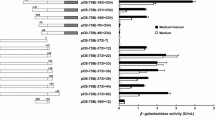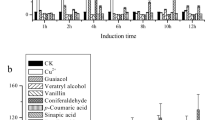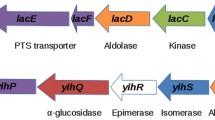Abstract
The xylA and xylB genes of Bacillus subtilis BR151 encoding xylose isomerase and xylulokinase, respectively, were disrupted by gene replacement rendering the constructed mutant strain unable to grow on xylose as the sole carbon source. The Bacillus megaterium encoded xyl genes were cloned by complementation of this strain to xylose utilization. The nucleotide sequence of about 4 kbp of the insertion indicates the presence of the xylA and xylB genes on the complementing plasmid. Furthermore, a regulatory gene, xylR, is located upstream of xylA and has opposite polarity to it. The intergenic region between the divergently oriented reading frames of xylR and xylA contains palindromic sequences of 24 bp spaced by five central bp and 29 bp spaced by 11 bp, respectively, and two promoters with opposite orientation as determined by primer extension analysis. They overlap with one nucleotide of their — 35 consensus boxes. Transcriptional fusions of lacZ to xylA, xylB and xylR were constructed and revealed that xylA and xylB are repressed in the absence and can be 200-fold induced in the presence of xylose. The increased level of xylAB mRNA in induced and its absence in repressed cells confirms that this regulation occurs on the level of transcription. Deletion of the xylR gene encoding the Xyl repressor results in constitutive expression of xylAB. The transcription of xylR is autoregulated and can be induced 9-fold by xylose. The mechanism of this regulation is not clear. While the apparent xyl operator palindrome is upstream of the xylR promoter, the potential recognition of another palindrome downstream of this promoter by Xyl repressor is discussed.
Similar content being viewed by others
References
Ausubel FM, Brent R, Kingston RE, More DD, Seidman JG, Smith JA, Struhl K (1987) Current protocols in molecular biology. Greene Publishing Associates and Wiley Interscience, New York
Batt CA, Bodis MS, Picataggio SK, Claps MC, Jamas S, Sinskey AJ (1985) Analysis of xylose operon regulation by Mud (Apr, lac) fusion: trans effect of plasmid coded xylose operon. Can J Microbiol 31:930–933
Bergmeyer HU (1974) Methoden der enzymatischen Analyse, 3rd edn. Verlag Chemie, Weinheim, FRG, pp 1416–1420
Birnboim HC, Doly J (1979) A rapid alkaline extraction procedure for screening recombinant plasmid DNA. Nucleic Acids Res 7:1513–1523
Boylan SA, Chun KT, Edson BA, Price CW (1988) Early-blocked sporulation mutations alter expression of enzymes under carbon control in Bacillus subtilis. Mol Gen Genet 212:271–280
Deveraux J, Haeberli P, Smithies O (1984) A compressive set of sequence analysis programs for the VAX. Nucleic Acids Res 13:387–395
Fouet A, Sonenshein AL (1990) A target for carbon source dependent negative regulation of the citB promoter of Bacillus subtilis. J Bacteriol 172:835–844
Gärtner D, Geissendörfer M, Hillen W (1988) Expression of Bacillus subtilis xyl operon is repressed at the level of transcription and is induced by xylose. J Bacteriol 170:3102–3109
Hardy KG (1985) Bacillus cloning methods. In: Glover DM (ed) DNA cloning, a practical approach, vol. 2. IRL Press, Oxford Washington DC, pp 1–17
Hastrup S (1988) Analysis of the Bacillus subtilis xylose regulon. In: Cranesan AT, Hoch JA (eds) Genetics and biotechnology of Bacilli, vol. 2. Academic Press, New York, pp 79–84
Hillen W, Klein RD, Wells RD (1981) Preparation of milligramm amounts of 21 deoxyribonucleic acid fragments. Biochemistry 20:3748–3756
Kreft J, Bernhard K, Goebel W (1978) Recombinant plasmids capable of replication in B. subtilis and E. coli. Mol Gen Genet 162:59–67
Kreuzer P, Gärtner D, Allmansberger R, Hillen W (1989) Identification and sequence analysis of the Bacillus subtilis W23 xylR gene and xyl operator. J Bacteriol 171:3840–3845
Lawlis VB, Dennis MS, Chen EY, Smith DH, Henner DJ (1984) Cloning and sequencing of the xylose isomerase and the xylulose kinase genes of Escherichia coli. Appl Environ Microbiol 47:15–21
Maniatis T, Fritsch EF, Sambrook J (1982) Molecular cloning: a laboratory manual. Cold Spring Harbor Laboratory, Cold Spring Harbor, NY
Marsh JL, Erfle M, Wykes EJ (1984) The plC plasmid and phage vectors with versatile cloning sites for recombinant selection by insertional inactivation. Gene 32:481–485
Miller JH (1972) Experiments in molecular genetics. Cold Spring Harbor Laboratories, Cold Spring Harbor, NY, pp 352–355
Moran CP, Lang N, LeGrice SFJ, Lee G, Stephens M, Sonenshein AL, Pero J, Losick R (1982) Nucleotide sequences that signal the initiation of transcription and translation in Bacillus subtilis. Mol Gen Genet 186:339–346
Müller B, Allmansberger R, Klein A (1985) Termination of a transcription unit comprising highly expressed genes in the archaebacterium Methanococcus voltae. Nucleic Acids Res 13:6439–6445
Nicholson WL, Park YK, Henkin TM, Won M, Weichert MJ, Gaskell JA, Chambliss GH (1987) Catabolite repression-resistant mutations of the Bacillus subtilis alpha amylase promotor affect transcription levels and are in an operator-like sequence. J Mol Biol 198:609–618
Ortlepp SA, Ollington JF, McConnell DJ (1983) Molecular cloning in Bacillus subtilis of a B. licheniformis gene encoding a thermostable alpha amylase. Gene 23:267–279
Puyet A, Sandoval H, Lopez P, Aguilar A, Martin JF, Espinosa M (1987) A simple medium for rapid regeneration of Bacillus subtilis protoplasts transformed with plasmid DNA. FEMS Microbiol Lett 40:1–5
Rüther U (1982) pUR allows rapid chemical sequencing of both strands of its inserts. Nucleic Acids Res 10:5765–5772
Sanger F, Nicklen S, Coulson AR (1977) DNA sequencing with chain terminating inhibitors. Proc Natl Acad Sci USA 74:5463–5467
Scheler A, Rygus T, Allmansberger R, Hillen W (1991) Molecular cloning, structure, promoters and regulatory elements for transcription of the Bacillus licheniformis encoded regulon for xylose utilization. Arch Microbiol 155:526–534
Schellenberg GD, Sarthy A, Larson AE, Backer MP, Crabb JW, Lidstrom M, Hall BD, Furlong CE (1984) Xylose isomerase from Escherichia coli. J Biol Chem 259:6826–6832
Shamanna DK, Sanderson KE (1979) Genetics and regulation of d-xylose utilization in Salmonella typhimurium LT2. J Bacteriol 139:71–79
Shimotsu H, Henner D (1986) Construction of a single copy intergration vector and its use in analysis of regulation of the trp operon of Bacillus subtilis. Gene 43:85–94
Sizemore C, Buchner E, Rygus T, Götz F, Hillen W (1991) Organization, structure, promotor analysis and transcriptional regulation of the xylose utilization operon from Staphylococcus xylosus. Mol Gen Genet (in press)
Soberon C, Covarrubias L, Bolivar F (1980) Construction and characterisation of new cloning vehicles, IV Delection derivatives of pBR322 and pBR325. Gene 9:287–305
Southern EM (1975) Detection of specific sequences among DNA fragments separated by gel electrophoresis. J Mol Biol 98:503–517
Sullivan MA, Yasbin RA, Young FE (1984) New shuttle vectors for Bacillus and Escherichia coli which allow rapid detection of inserted fragments. Gene 29:21–26
Wilhelm M, Hollenberg CP (1984) Selective cloning of Bacillus subtilis xylose isomerase and xylulokinase genes in Escherichia coli by IS5-mediated expression. EMBO J 3:2555–2560
Wilhelm M, Hollenberg CP (1985) Nucleotide sequence of the Bacillus subtilis xylose isomerase gene: extensive homology between the Bacillus and the E. coli enzyme. Nucleic Acids Res 13:5717–5722
Wilkie KCB (1979) The hemicelluloses of grasses and cereals. Adv Carbohydr Chem Biochem 36:215–264
Williams JG, Mason PJ (1985) Hybridisation in the analysis of RNA. In: Hames BD, Higgins SJ (eds) Nucleic acid hybridisation, a practical aproach. IRL Press, Oxford Washington DC, p 152
Yanisch-Perron C, Vieira J, Messing J (1985) Improved M13 phage cloning vectors and host strains: nucleotide sequences of the M13mp18 and the pUC19 vectors. Gene 33:103–119
Youngman P (1987) Plasmid vectors for recovering and exploiting Tn917 transpositions in Bacillus and other gram positive bacteria. In: Hardy KG (ed) Plasmids, a practical approach. IRL Press, Oxford, Washington DC, pp 79–103
Author information
Authors and Affiliations
Rights and permissions
About this article
Cite this article
Rygus, T., Scheler, A., Allmansberger, R. et al. Molecular cloning, structure, promoters and regulatory elements for transcription of the Bacillus megaterium encoded regulon for xylose utilization. Arch. Microbiol. 155, 535–542 (1991). https://doi.org/10.1007/BF00245346
Received:
Accepted:
Issue Date:
DOI: https://doi.org/10.1007/BF00245346




